Biopharmaceutical Fermentation Market Size
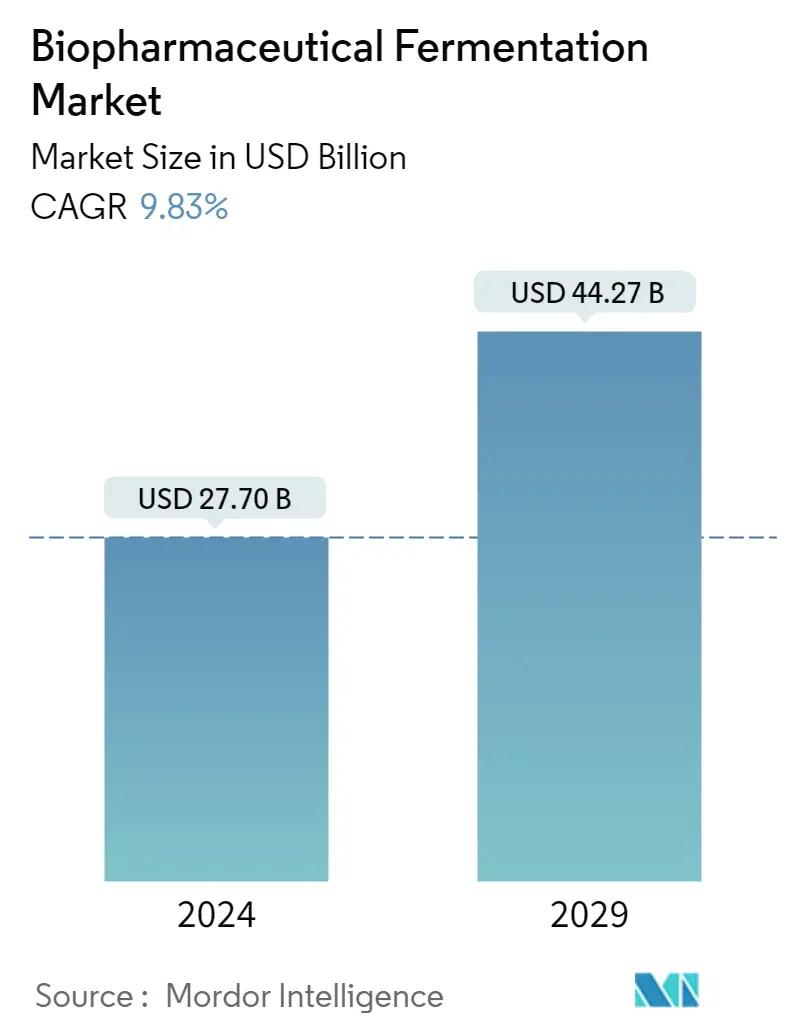
| Study Period | 2021 - 2029 |
| Market Size (2024) | USD 27.70 Billion |
| Market Size (2029) | USD 44.27 Billion |
| CAGR (2024 - 2029) | 9.83 % |
| Fastest Growing Market | Asia-Pacific |
| Largest Market | North America |
Major Players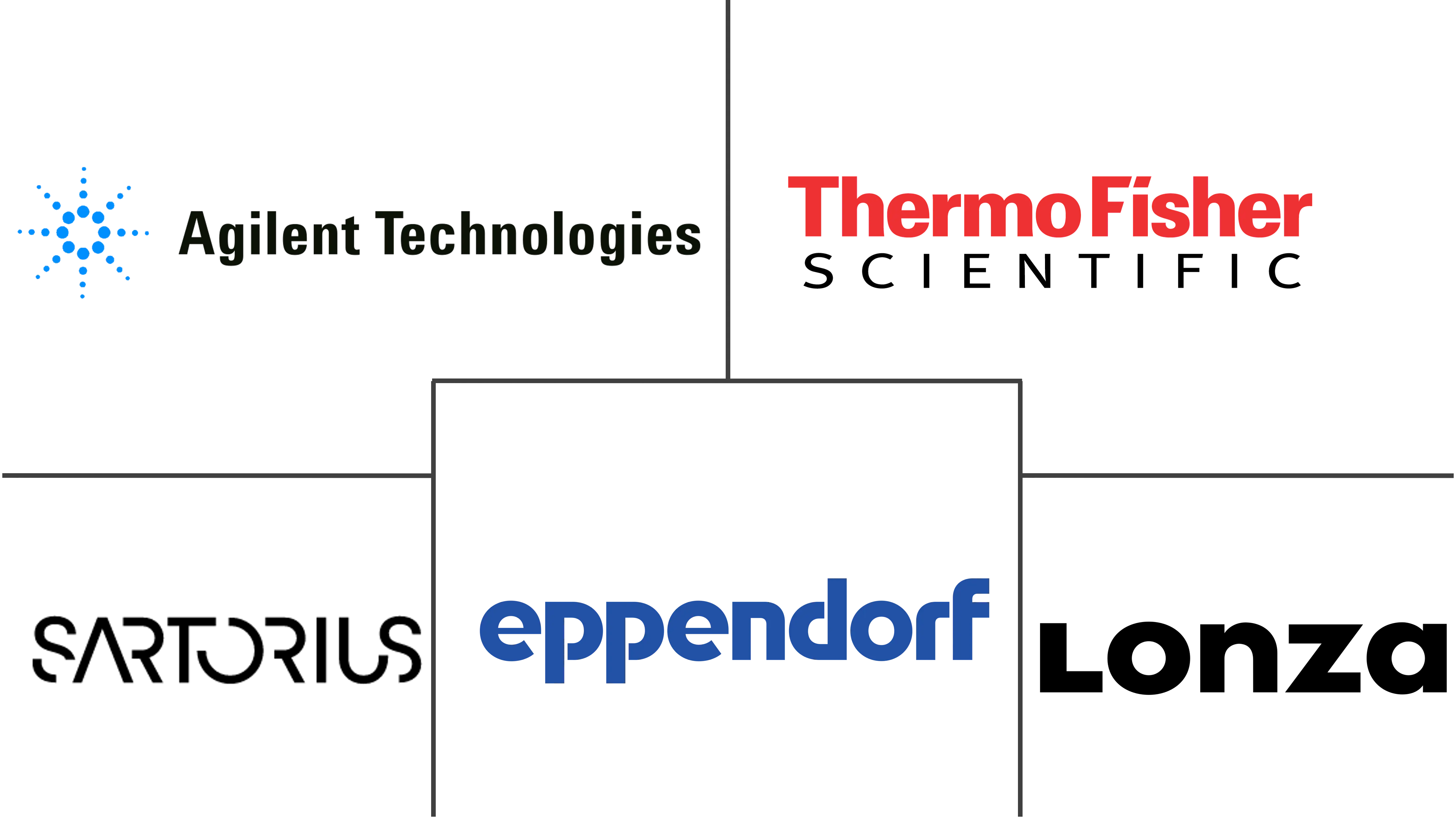
*Disclaimer: Major Players sorted in no particular order |
Biopharmaceutical Fermentation Market Analysis
The Biopharmaceutical Fermentation Market size is estimated at USD 27.70 billion in 2024, and is expected to reach USD 44.27 billion by 2029, growing at a CAGR of 9.83% during the forecast period (2024-2029).
COVID-19 has impacted the growth of the biopharmaceutical fermentation market. The pandemic resulted in an unprecedented demand for enzymes essential for innovative point-of-care diagnostic kits and mRNA vaccines. For instance, according to the report published by MassBio, in December 2022, it has been observed that the COVID-19 epidemic has increased and reinforced the demand for complex fermentation products in the pharmaceutical and biotechnology industries. Globally, companies and populations benefited from crucial supplies of enzymes produced by fermentation. Moreover, the production of new biologic drugs during the pandemic period for the treatment of COVID-19 infection increased which has impacted the market growth. For instance, in December 2021, Samsung Biologics and AstraZeneca expanded a strategic biopharmaceutical production partnership to include therapies for Covid-19. However, the emergence of a new variety of viruses accelerates vaccine production which involves the fermentation step. For instance, in July 2022, CEPI funded USD 30 million to bring a new nanoparticle vaccine offering protection against a range of coronaviruses to clinical trials. Thus, with such initiatives, the studied market is expected to grow and regain its full potential in the coming years.
Factors such as the increasing demand for biotech-based drugs and rising research and development activities to produce novel biological drugs are boosting market growth. For instance, according to the 2021 annual report of AbbVie, Humira is one of the top-selling biotechnology drugs in the world which accounted for net revenues of USD 20.7 billion and approximately 37% of AbbVie's total net revenues in 2021. Globally, Humira sales increased by 4% in 2021 compared with the previous year. Similarly, as per the 2021 annual report of Merck & Co, the sales of Keytruda, one of the major biotech-based drugs of the company, grew by 20% to USD 17.2 Billion, compared to USD 14.9 Billion in the year 2020. Thus, the increasing sales of biotech-based drugs in the market indicates the increasing demand for these drugs in the market which in turn is anticipated to fuel the market growth over the forecast period.
Furthermore, the rising company focus on developing novel biological drugs is also expected to fuel the demand for fermentation services and products which is anticipated to propel the market growth. For instance, in November 2022, Eikonoklastes Therapeutics, a preclinical biotech company, and Forge Biologics, a gene therapy-focused contract development and manufacturing organization entered a manufacturing partnership that will advance Eikonoklastes' AAV-based gene therapy, ET-101, into clinical trials for the treatment of patients with amyotrophic lateral sclerosis (ALS). Also, in August 2022, Sanofi and Innovent Biologics entered a strategic collaboration to accelerate the development of two biologic oncology medicines (tusamitamab ravtansine, SAR444245) and expand their presence in China.
Therefore, owing to the factors, such as the rising company activities and increasing demand for biotech-based drugs, the studied market is anticipated to grow over the forecast period. However, the high cost of biopharmaceutical fermentation and installation is likely to impede the growth of the biopharmaceutical fermentation market over the forecast period.
Biopharmaceutical Fermentation Market Trends
This section covers the major market trends shaping the Biopharmaceutical Fermentation Market according to our research experts:
Chromatography Segment Expects to Register a Significant CAGR Over the Forecast Period
The chromatography segment is expected to witness significant growth in the biopharmaceutical fermentation market over the forecast period. The factors attributing to the segment growth are the growing demand for novel biopharmaceutical drugs coupled with the launch of new products.
The process of chromatography is used to separate molecules according to their sizes, charges, hydrophobicity, and particular ligand binding. Depending on the physical and chemical nature of the fermentation products, the cell-free broth is subjected to the type of chromatography. For instance, the purification of recombinant human insulin and the separation of biological variant insulin molecules from different species is done by reversed-phase high-performance liquid chromatography (HPLC).
The introduction of new devices increases the availability of products in the market which is expected to boost the segment growth. For instance, in October 2021, Thermo Fisher Scientific launched the Thermo Scientific HyPeak Chromatography System. It is one of the first single-use chromatography systems for bioprocessing and offers a wide operational flow range, from 1LPH to 1,980LPH, through a combination of pumps and fluid transfer assemblies (FTA) that enable scalability from process development to cGMP manufacturing. Also, in October 2021, Novasep launched the Hipersep Process M. It is an HPLC chromatography system designed for the purification of pharmaceutical molecules such as peptides, oligonucleotides, insulin, and other synthetic molecules.
Furthermore, the growing technological advancements in chromatography techniques are expected to increase its adoption by the biopharmaceutical industries. This is expected to boost segment growth. For instance, in January 2021, Cytiva further advanced the fiber chromatography technology with the release of Fibro technology-based HiScreen Fibro PrismA. It is one of the newest products available for early monoclonal antibody (mAb) purification process development.
Thus, owing to the aforementioned factors such as the launch of products and advancement in technology, the chromatography segment is expected to project significant growth over the forecast period.
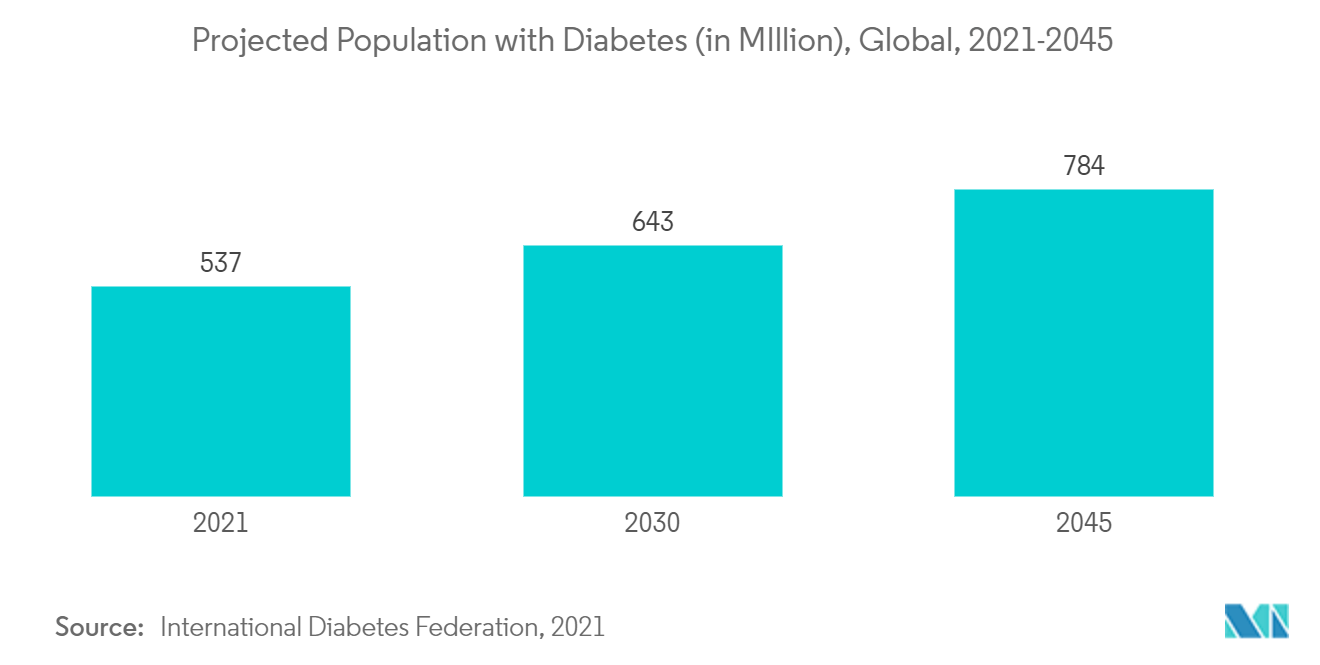
North America is Expected to Dominate the Biopharmaceutical Fermentation Market
North America is expected to witness significant growth in the biopharmaceutical market over the forecast period owing to the factors such as the increasing demand for biotech-based drugs, rising research and development activities, and growing expenditure for the development and advancements in biopharmaceutical fermentation. In addition, the rise in the frequency of chronic diseases rises the consumption of medicines which in turn helps to grow the biopharmaceutical industry and offers growth opportunities for the market players by increasing demand for biologics and biotech drugs which will ultimately propel the utility of biopharmaceutical fermentation.
The rising demand for biopharmaceutical fermentation in the biopharmaceutical sector to reduce the toxicity of drugs and bacterial resistance and increase its efficacy attracts various companies to research and development using biopharmaceutical fermentation. For instance, in August 2022, the National Institute for Innovation in Manufacturing Biopharmaceuticals (NIIMBL) of the United States granted funding of USD 15.8 million for 14 new technology and workforce development projects that address key opportunities for innovation in the biopharmaceutical sector.
Additionally, the growing prevalence of diseases, such as diabetes, rheumatoid arthritis, and cancer in the region is contributing to the market's growth owing to the use of biopharmaceutical fermentation in manufacturing biotech drugs and biological drugs. For instance, about 32 million and 14 million living in the United States and Mexico were suffering from diabetes in 2021 and this number is projected to reach 36.2 million and 21.8 million by 2045, respectively. Also, as per the 2022 statistics published by ACS, about 1.9 million people living in America were diagnosed with cancer in the United States in 2022. Thus, the high burden of cancer and diabetes among the population raises the demand for effective biological drugs which in turn is anticipated to fuel the market growth over the forecast period.
Furthermore, the rising company focuses on adopting various business strategies such as product launches, approvals, fundraising, and partnerships to expand their offerings in the biopharmaceutical industry are expected to drive the growth of this market. For instance, in February 2022, Kerry Group plc acquired Enmex S.A., an enzyme manufacturer based in Mexico for EUR 62 million. The acquisition accelerates Kerry's innovation capabilities in enzyme engineering, fermentation, and bioprocess development. Also, in September 2021, Thermo Fisher Scientific announced its plan to expand its Nashville, Tenn. site by establishing a dedicated single-use technology manufacturing facility at the site, doubling capacity. The expansion is likely to use bioreactors on a large scale for the manufacturing of biological drugs.
Therefore, owing to the factors such as the high burden of diabetes, and cancer, growing demand for biopharmaceutical fermentation, and rising company activities, the studied market is anticipated to grow over the forecast period.
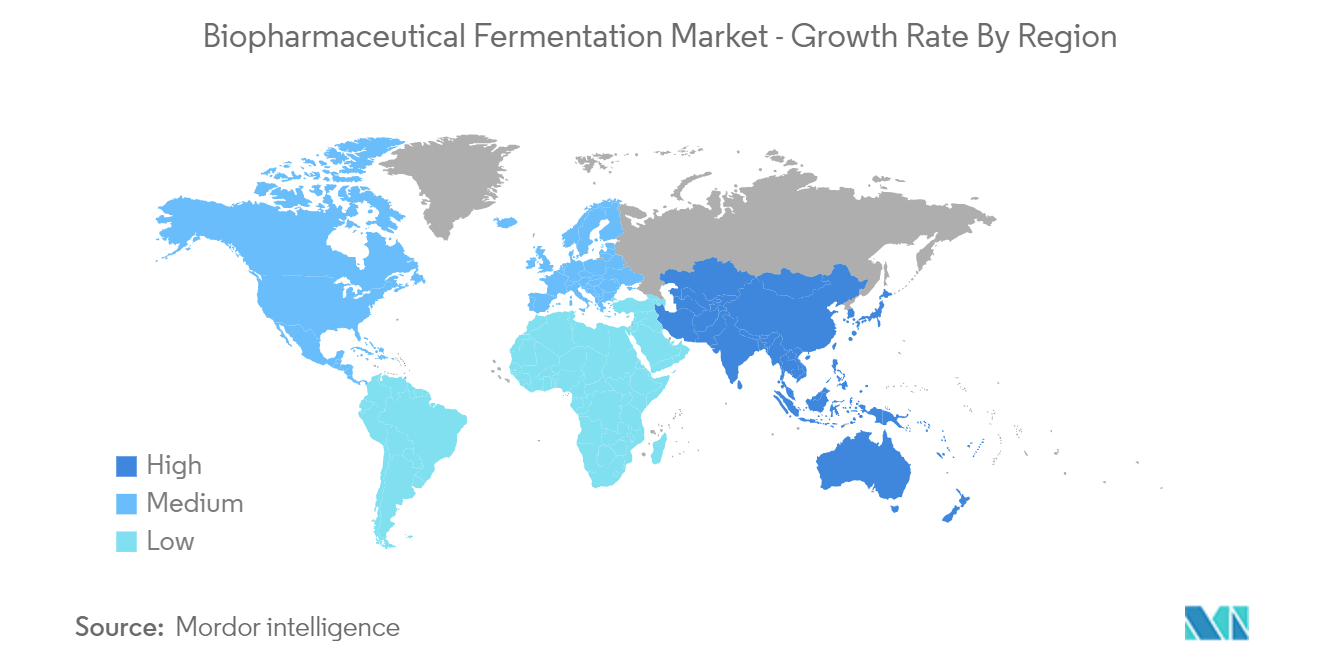
Biopharmaceutical Fermentation Industry Overview
The biopharmaceutical fermentation market is fragmented in nature due to the presence of several companies operating globally as well as regionally. The competitive landscape includes an analysis of a few international as well as local companies which hold the market shares including Thermo Fisher Scientific Inc., Danaher Corporation, Sartorius Stedim Biotech, Merck KGaA, Eppendorf AG, F. Hoffmann-La Roche Ltd., Nova Biomedicals, Lonza Group AG, Agilent Technologies, Becton, Dickinson, and Company among others.
Biopharmaceutical Fermentation Market Leaders
-
Eppendorf AG
-
Lonza Group AG
-
Thermo Fisher Scientific Inc.
-
Sartorius Stedim Biotech
-
Agilent Technologies
*Disclaimer: Major Players sorted in no particular order
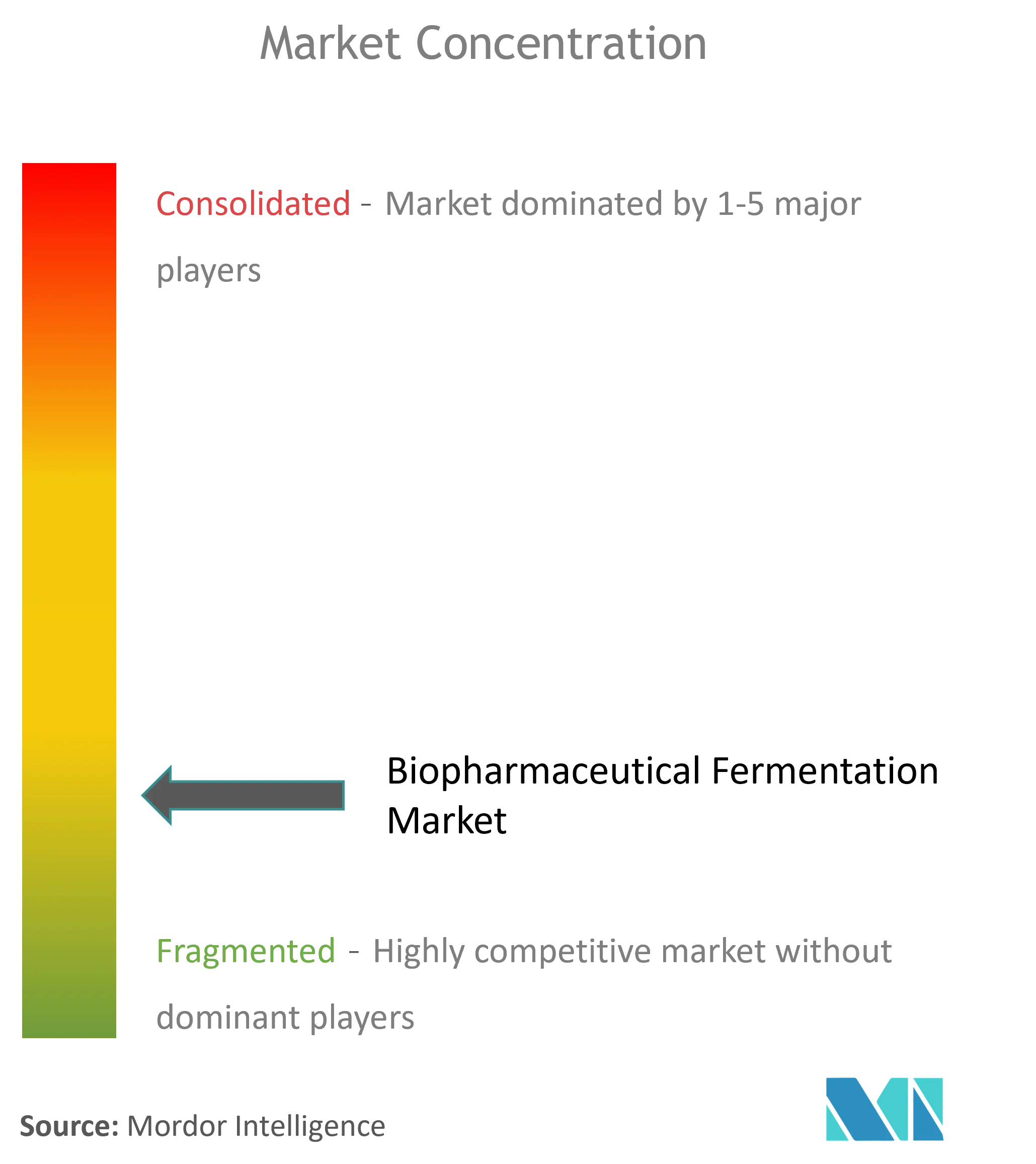
Biopharmaceutical Fermentation Market News
- In December 2022, MilliporeSigma acquired Massachusetts-based Erbi Biosystems, a developer of the 2 ml micro-bioreactor platform technology, known as the Breez. The acquisition assists the company to strengthen company's upstream portfolio in therapeutic proteins by enabling scalable cell-based perfusion bioreactor processes from 2ml to 2000L with rapid lab-scale process development.
- In October 2022, Froilabo (Japan) introduced a new line of completely automated lab-scale bioreactors. The bioreactors, which complement their line of temperature-controlled laboratory equipment, provide a wide range of application possibilities for academics, research, process development and optimization, scale-up, and manufacturing.
Biopharmaceutical Fermentation Market Report - Table of Contents
1. INTRODUCTION
- 1.1 Study Assumptions and Market Definition
- 1.2 Scope of the Study
2. RESEARCH METHODOLOGY
3. EXECUTIVE SUMMARY
4. MARKET DYNAMICS
- 4.1 Market Overview
-
4.2 Market Drivers
- 4.2.1 Increasing Demand for Biotech based Drugs
- 4.2.2 Rising Research and Development Activities to Produce Novel Biological Drugs
-
4.3 Market Restraints
- 4.3.1 High Cost of Biopharmaceutical Fermentation and its Installation
-
4.4 Porter's Five Force Analysis
- 4.4.1 Threat of New Entrants
- 4.4.2 Bargaining Power of Buyers/Consumers
- 4.4.3 Bargaining Power of Suppliers
- 4.4.4 Threat of Substitute Products
- 4.4.5 Intensity of Competitive Rivalry
5. MARKET SEGMENTATION (Market Size by Value - USD million)
-
5.1 By Product Type
- 5.1.1 Upstreams Products
- 5.1.1.1 Bioreactors/Fermentors
- 5.1.1.2 Bioprocess Analyzers
- 5.1.1.3 Process Monitoring System
- 5.1.1.4 Other Upstream Products
- 5.1.2 Downstream Products
- 5.1.2.1 Filtration and Seperation
- 5.1.2.2 Chromatography
- 5.1.2.3 Consumables and Acessories
- 5.1.2.4 Other Downstream Products
-
5.2 By Application
- 5.2.1 Antibiotics
- 5.2.2 Recombinant Proteins
- 5.2.3 Other Applications
-
5.3 By End User
- 5.3.1 Biopharmaceutical Industries
- 5.3.2 Contract Research Organization
- 5.3.3 Acedemic Research Institutes
- 5.3.4 Other End users
-
5.4 Geography
- 5.4.1 North America
- 5.4.1.1 United States
- 5.4.1.2 Canada
- 5.4.1.3 Mexico
- 5.4.2 Europe
- 5.4.2.1 Germany
- 5.4.2.2 United Kingdom
- 5.4.2.3 France
- 5.4.2.4 Italy
- 5.4.2.5 Spain
- 5.4.2.6 Rest of Europe
- 5.4.3 Asia-Pacific
- 5.4.3.1 China
- 5.4.3.2 Japan
- 5.4.3.3 India
- 5.4.3.4 Australia
- 5.4.3.5 South Korea
- 5.4.3.6 Rest of Asia-Pacific
- 5.4.4 Middle East and Africa
- 5.4.4.1 GCC
- 5.4.4.2 South Africa
- 5.4.4.3 Rest of Middle East and Africa
- 5.4.5 South America
- 5.4.5.1 Brazil
- 5.4.5.2 Argentina
- 5.4.5.3 Rest of South America
6. COMPETITIVE LANDSCAPE
-
6.1 Company Profiles
- 6.1.1 Agilent Technologies
- 6.1.2 Thermo Fisher Scientific Inc.
- 6.1.3 Lonza Group AG
- 6.1.4 Sartorius Stedim Biotech
- 6.1.5 Eppendorf AG
- 6.1.6 Danaher Corporation
- 6.1.7 F. Hoffmann-La Roche Ltd.
- 6.1.8 Nova Biomedical Corporation
- 6.1.9 Merck KGaA
- 6.1.10 Becton, Dickinson and Company
- *List Not Exhaustive
7. MARKET OPPORTUNITIES AND FUTURE TRENDS
** Subject To AvailablityBiopharmaceutical Fermentation Industry Segmentation
As per the scope of the report, biopharmaceutical fermentation systems or bioprocessing can be defined as the process of incubating microorganisms within an enclosed tank, under controlled conditions of aeration, agitation, temperature, and pH. Upstream bioprocessing deals with the use of living cells to obtain desired products, where the process starts from early cell separation, and cultivation to cell culture expansion to harvest. Downstream processing includes the recovery and purification of biological products. The downstream is an essential part of the manufacturing of vaccines, antibodies, antibiotics, and hormones, such as insulin and human growth hormone. The Biopharmaceutical Fermentation Market is Segmented by Product Type (Upstream products (Bioreactors/Fermenters, Bioprocess Analyzers, Process Monitoring Systems, and Other Upstream Products), and Downstream Products (Filtration and Separation, Chromatography, Consumables and Accessories, and Other Downstream Products), Applications (Antibiotics, Recombinant Proteins, Probiotics, and Other Applications), End User (Biopharmaceutical Industries, Contract Research Organizations (CROs) and CDMOs, Academic Research Institutes), and Geography (North America, Europe, Asia-Pacific, Middle East, Africa, and South America). The market report also covers the estimated market sizes and trends for 17 countries across major regions globally. The report offers the value (in USD million) for the above segments.
| By Product Type | Upstreams Products | Bioreactors/Fermentors |
| Bioprocess Analyzers | ||
| Process Monitoring System | ||
| Other Upstream Products | ||
| By Product Type | Downstream Products | Filtration and Seperation |
| Chromatography | ||
| Consumables and Acessories | ||
| Other Downstream Products | ||
| By Application | Antibiotics | |
| Recombinant Proteins | ||
| Other Applications | ||
| By End User | Biopharmaceutical Industries | |
| Contract Research Organization | ||
| Acedemic Research Institutes | ||
| Other End users | ||
| Geography | North America | United States |
| Canada | ||
| Mexico | ||
| Geography | Europe | Germany |
| United Kingdom | ||
| France | ||
| Italy | ||
| Spain | ||
| Rest of Europe | ||
| Geography | Asia-Pacific | China |
| Japan | ||
| India | ||
| Australia | ||
| South Korea | ||
| Rest of Asia-Pacific | ||
| Geography | Middle East and Africa | GCC |
| South Africa | ||
| Rest of Middle East and Africa | ||
| Geography | South America | Brazil |
| Argentina | ||
| Rest of South America |
Biopharmaceutical Fermentation Market Research FAQs
How big is the Biopharmaceutical Fermentation Market?
The Biopharmaceutical Fermentation Market size is expected to reach USD 27.70 billion in 2024 and grow at a CAGR of 9.83% to reach USD 44.27 billion by 2029.
What is the current Biopharmaceutical Fermentation Market size?
In 2024, the Biopharmaceutical Fermentation Market size is expected to reach USD 27.70 billion.
Who are the key players in Biopharmaceutical Fermentation Market?
Eppendorf AG, Lonza Group AG, Thermo Fisher Scientific Inc., Sartorius Stedim Biotech and Agilent Technologies are the major companies operating in the Biopharmaceutical Fermentation Market.
Which is the fastest growing region in Biopharmaceutical Fermentation Market?
Asia-Pacific is estimated to grow at the highest CAGR over the forecast period (2024-2029).
Which region has the biggest share in Biopharmaceutical Fermentation Market?
In 2024, the North America accounts for the largest market share in Biopharmaceutical Fermentation Market.
What years does this Biopharmaceutical Fermentation Market cover, and what was the market size in 2023?
In 2023, the Biopharmaceutical Fermentation Market size was estimated at USD 25.22 billion. The report covers the Biopharmaceutical Fermentation Market historical market size for years: 2021, 2022 and 2023. The report also forecasts the Biopharmaceutical Fermentation Market size for years: 2024, 2025, 2026, 2027, 2028 and 2029.
Biopharmaceutical Fermentation Industry Report
Statistics for the 2024 Biopharmaceutical Fermentation market share, size and revenue growth rate, created by Mordor Intelligence™ Industry Reports. Biopharmaceutical Fermentation analysis includes a market forecast outlook 2029 and historical overview. Get a sample of this industry analysis as a free report PDF download.



